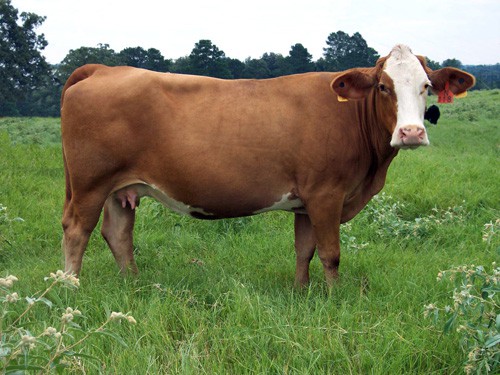Type the name of the breed you're looking for below
[wpdreams_ajaxsearchlite] Don't see the breed your're looking for? Click here and let us know!
Simbrah cattle
| Place of Origin | United States |
| Origin | An experiment combining Simmental with Brahman that began in the pastures of a few dedicated cattlemen in the late 1960s has evolved logically into the breed called Simbrah. The Brahman or Zebu, the most numerous cattle type on earth, contributes heat and insect tolerance, hardiness and excellent foraging ability, as well as maternal calving ease and longevity. The Simmental complements these excellent traits with early sexual maturity, fertility, milking ability, rapid growth and good beef characteristics. The very docile disposition of most Simmental is also a plus for this composite. These two cattle breeds have been used in cooperation to produce Simbrah, superior in many ways to the parent breeds. Simbrah has been described as "The All Purpose American Breed". Developed in America, Simbrah genetics may be called on to infuse superior maternal traits into a herd. Or, due to their rapid growth, vigor, and heat tolerance, Simbrah may be the answer in a terminal cross program. In the final analysis, Simbrah will produce a lean, high quality beef product. Originally developed in the hot, humid areas of the Gulf Coast, Simbrah have shown they can Thrive in the Northwest and Northeast regions of the United States where temperatures may range 115 degrees in the summer to 25 degrees below zero in the winter. There is great interest in the breed worldwide. Simbrah are being developed in many areas where Zebu breeding predominates as well as other areas where Simbrahs unique blend of features is desired. Breeds of Simbrah know the importance of producing practical cattle with economic advantages. Simbrah have been developed to be as functional and trouble free as possible. Breeders stress structurally sound underlines, i.e. a clean sheath teamed with large scrotal size on the bulls and a well-attached udder with small teats on the cows. Many also put emphasis on pigmented eyes, thick muscling, and reasonable dispositions. Some programs produce polled Simbrah. Commercial operators appreciate the long and productive life span of Simbrah cattle. Frequently, well beyond 10 years of age, unpampered cows are still weaning heavy calves and bulls are still breeding. This can mean a significant savings in replacement costs for the rancher. After weaning, most Simbrah calves will perform well if placed directly in the feedlot. At this phase in their lives, they are growing rapidly and will gain very efficiently. They can produce a very desirable carcass at 12-15 months of age. Enthusiastic Simbrah breeders are utilizing all the tools, animal science and technology available to modern animal breeders. They have a broad genetic base in which to work and a sophisticated evaluation program for performance and progeny information. The Simbrah Registry is kept by the American Simmental Association. |
| Purpose | Meat |
| Appearance | They are a hardy breed, that are large and have red coats. |
| Horns | Naturally polled (hornless) |



